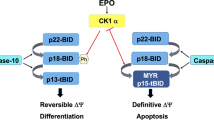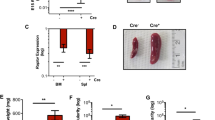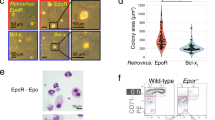Abstract
Previous studies have demonstrated that SH2-containing inositol phosphatase (SHIP) is involved in the control of B cell, myeloid cell and macrophage activation and proliferation. The goal of the present study was to examine the role of SHIP during proliferation and apoptosis in cells of the erythroid lineage. Wild-type and catalytically inactive SHIP proteins were overexpressed in the erythropoietin (EPO)-dependent cell line AS-E2. Stable overexpression of catalytically inactive SHIP decreased proliferation and resulted in prolonged activation of the extracellular signal-regulated protein kinases ERK1/2 and protein kinase B (PKB), while wild-type SHIP did not affect EPO-mediated proliferation or phosphorylation of ERK and PKB. When AS-E2 cells were EPO deprived a significant increase in apoptosis was observed in clones overexpressing wild type. Mutational analysis showed that this increase in apoptosis was independent of the enzymatic activity of SHIP. The enhanced apoptosis due to overexpression of SHIP was associated with an increase in caspase-3 and -9 activity, without a distinct effect on caspase-8 activity or mitochondrial depolarization. Moreover, in cells overexpressing SHIP apoptosis could be reduced by a caspase-3 inhibitor. These data demonstrate that in the erythroid cell line AS-E2 overexpression of catalytically inactive SHIP reduced proliferation, while overexpression of wild-type SHIP had no effect. Furthermore, overexpression of SHIP enhanced apoptosis during growth factor deprivation by inducing specific caspase cascades, which are regulated independently of the 5-phosphatase activity of SHIP.
This is a preview of subscription content, access via your institution
Access options
Subscribe to this journal
Receive 12 print issues and online access
$259.00 per year
only $21.58 per issue
Buy this article
- Purchase on Springer Link
- Instant access to full article PDF
Prices may be subject to local taxes which are calculated during checkout






Similar content being viewed by others
References
Wu H, Liu X, Jaenisch R, Lodish HF . Generation of committed erythroid BFU-E and CFU-E progenitors does not require erythropoietin or the erythropoietin receptor Cell 1995 83: 59–67
de Wolf JThM, Muller EW, Hendriks D, Halie RM, Vellenga E . Mast cell growth factor modulates CD36 antigen expression on erythroid progenitors from human bone marrow and peripheral blood associated with ongoing differentiation Blood 1994 84: 59–64
Brada S, Wolf JThMd, Hendriks D, Esselink MT, Ruiters M, Vellenga E . The supportive effects of erythropoietin and mast cell growth factor on CD34+/CD36− sorted bone marrow cells of myelodysplasia patients Blood 1996 88: 505–510
Nosaka T, Kawashima T, Misawa K, Ikuta K, Mui AL, Kitamura T . STAT5 as a molecular regulator of proliferation, differentiation and apoptosis in hematopoietic cells EMBO J 1999 18: 4754–4765
Damen JE, Krystal G . Early events in erythropoietin-induced signaling Exp Hematol 1996 24: 1455–1459
Haseyama Y, Sawada K, Oda A, Koizumi K, Takano H, Tarumi T, Nishio M, Handa M, Ikeda Y, Koike T . Phosphatidylinositon 3-kinase is involved in the protection of primary cultured human erythroid precursor cells from apoptosis Blood 1999 94: 1568–1577
Drayer AL, Pesesse X, De Smedt F, Woscholski R, Parker P, Erneux C . Cloning and expression of a human placenta inositol 1,3,4,5- tetrakisphosphate and phosphatidylinositol 3,4,5-trisphosphate 5- phosphatase Biochem Biophys Res Commun 1996 225: 243–249
Damen JE, Liu L, Rosten P, Humphries RK, Jefferson AB, Majerus PW, Krystal G . The 145-kDa protein induced to associate with Shc by multiple cytokines is an inositol tetraphosphate and phosphatidylinositol 3,4,5- triphosphate 5-phosphatase Proc Natl Acad Sci USA 1996 93: 1689–1693
Lioubin MN, Algate PA, Tsai S, Carlberg K, Aebersold A, Rohrschneider LR . p150Ship, a signal transduction molecule with inositol polyphosphate-5- phosphatase activity Genes Dev 1996 10: 1084–1095
Kavanaugh WM, Pot DA, Chin SM, Deuter-Reinhard M, Jefferson AB, Norris FA, Masiarz FR, Cousens LS, Majerus PW, Williams LT . Multiple forms of an inositol polyphosphate 5-phosphatase form signaling complexes with Shc and Grb2 Curr Biol 1996 6: 438–445
Liu Q, Shalaby F, Jones J, Bouchard D, Dumon DJ . The SH2-containing inositol polyphosphate 5–phosphatase, SHIP, is expressed during hematopoiesis and spermatogenisis Blood 1998 91: 2753–2759
Liu L, Damen JE, Hughes MR, Babic I, Jirik FR, Krystal G . The Src homology 2 (SH2) domain of SH2-containing inositol phosphatase (SHIP) is essential for tyrosine phosphorylation of SHIP, its association with Shc, and its induction of apoptosis J Biol Chem 1997 272: 8983–8988
Sattler M, Salgia R, Shrikhande G, Verma S, Choi JL, Rohrschneider LR, Griffin JD . The phosphatidylinositol polyphosphate 5-phosphatase SHIP and the protein tyrosine phosphatase SHP-2 form a complex in hematopoietic cells which can be regulated by BCR/ABL and growth factors Oncogene 1997 15: 2379–2384
Liu L, Damen JE, Ware MD, Krystal G . Interleukin-3 induces the association of the inositol 5-phosphatase SHIP with SHP2 J Biol Chem 1997 272: 10998–11001
Gupta N, Scharenberg AM, Fruman DA, Cantley LC, Kinet J-P, Long EO . The SH2 domain-containing inositol 5′-phosphatase (SHIP) recruits the p85 subunit of phosphoinositide 3-kinase during Fc gamma RIIb1 mediated inhibition of B cell receptor signaling J Biol Chem 1999 274: 7489–7494
Lecoq-Lafon C, Verdier F, Fichelson S, Chrétien S, Gisselbrecht S, Lacombe C, Mayeux P . Erythropoietin induces the tyrosine phosphorylation of GAB-1 and its association with Shc, SHP2 and SHIPand phosphatidylinositol 3-kinase Blood 1999 93: 2578–2585
Hunter MG, Avalos BR . Phosphatidylinositol 3′-kinase and SH2-containing inositol phosphatase (SHIP) are recruited by distinct positive and negative growth-regulatory domains in the granulocyte colony-stimulating factor receptor J Immunol 1998 160: 4979–4987
Ingham RJ, Okada H, Dang-Lawson M, Dinglasan J, van der Geer P, Kurosaki T, Gold MR . Tyrosine phosphorylation of Shc in response to B cell antigen receptor engagement depends on the SHIP inositol phosphatase J Immunol 1999 163: 5891–5895
Liu Q, Oliveira-Dos-Santos AJ, Mariathasan S, Bouchard D, Jones J, Sarao R, Kozieradzki I, Ohashi PS, Penninger JM, Dumont DJ . The inositol polyphosphate 5-phosphatase SHIP is a crucual negative regulator of B cell antigen receptor signaling J Exp Med 1998 188: 1333–1342
Ono M, Bolland S, Tempst P, Ravetch JV . Role of the inositol phosphatase SHIP in negative regulation of the immune system by the receptor Fc-gamma-RIIB Nature 1996 383: 263–267
Petrie RJ, Schnetkamp PP, Patel KD, Awasthi-Kalia M, Deans JP . Transient translocation of the B cell receptor and Src homology 2 domain-containing inositol phosphatase to lipid rafts: evidence toward a role in calcium regulation J Immunol 2000 165: 1220–1227
Giuriato S, Payrastre B, Drayer AL, Plantavid M, Woscholski R, Parker P, Erneux C, Chap H . Tyrosine phosphorylation and relocation of SHIP are integrin-mediated in thrombin-stimulated human blood platelets J Biol Chem 1997 272: 26857–26863
Huber M, Helgason CD, Scheid MP, Duronio V, Humphries RK, Krystal G . Targeted disruption of SHIP leads to Steel factor-induced degranulation of mast cells EMBO J 1998 17: 7311–7319
Vollenweider P, Clodi M, Martin SS, Imamura T, Kavanaugh WM, Olefsky JM . An SH2 domain-containing 5′ inositolphosphatase inhibits insulin-induced GLUT4 translocation and growth factor induced actin filament rearrangement Mol Cell Biol 1999 19: 1081–1091
Kim CH, Hangoc G, Cooper S, Helgason CD, Yew S, Humphries RK, Krystal G, Broxmeyer HE . Altered responsiveness to chemokines due to targeted disruption of SHIP J Clin Invest 1999 104: 1751–1759
Helgason CD, Damen JE, Rosten P, Grewal R, Sorensen P, Chappel SM, Borowski A, Jirik F, Krystal G, Humphries RK . Targeted disruption of SHIP leads to hemopoietic perturbations, lung pathology, and a shortened life span Genes Dev 1998 12: 1610–1620
Liu Q, Sasaki T, Kozieradzki I, Wakeham A, Itie A, Dumont DJ, Penninger JM . SHIP is a negative regulator of growth factor receptor-mediated PKB/Akt activation and myeloid cell survival Genes Dev 1999 13: 786–791
Aman MJ, Lamkin TD, Okada H, Kurosaki T, Ravichandran KS . The inositol phosphatase SHIP inhibits Akt/PKB activation in B cells J Biol Chem 1998 273: 33922–33928
Huber M, Helgason CD, Damen JE, Liu L, Humphries RK, Krystal G . The scr homology 2-containing inositol phosphatase (SHIP) is the gatekeeper of mast cell degranulation Proc Natl Acad Sci USA 1998 95: 11330–11335
Miyazaki Y, Kuriyama K, Higuchi M, Tsushima H, Sohda H, Imai N, Saito M, Konto T, Tomonaga M . Establishment and characterization of a new erythropoietin-dependent acute myeloid leukemia cell line, AS-E2 Leukemia 1997 11: 1941–1949
Tsushima H, Urata Y, Miyazaki Y, Fuchigami K, Kuriyama K, Kondo T, Tomonaga M . Human erythropoietin receptor increases GATA-2 and Bcl-XL by a protein kinase C-dependent pathway in human erythropoietin-dependent cell line AS-E2 Cell Growth Differ 1997 8: 1317–1328
de Smedt F, Boom A, Pesesse X, Schiffmann SN, Erneux C . Post-translational modification of human brain type I inositol-1,4,5-triphosphate 5-phosphatase by farnesylation J Biol Chem 1996 271: 10419–10424
Tuyt LML, Bregman K, Lummen C, Dokter WH, Vellenga E . Differential binding activity of the transcription factor LIL-Stat in immature and differentiated normal and leukemic myeloid cells Blood 1998 92: 1364–1373
Hildeman DA, Mitchell T, Teague TK, Henson P, Day BJ, Kappler J, Marrack PhC . Reactive oxygen species regulate activation-induced T cell apoptosis Immunity 1999 10: 735–744
Jefferson AB, Majerus PW . Mutation of the conserved domains of two inositol polyphosphate 5-phosphatases Biochemistry 1996 35: 7890–7894
Xue L, Murray JH, Tolkovsky AM . The Ras/phosphatidylinositol 3-kinase and Ras/ERK pathways function as independent survival modules each of which inhibits a distinct apoptotic signaling pathway in sympathetic neurons J Biol Chem 2000 275: 8817–8824
Tsushima H, Imaizumi Y, Imanishi D, Fuchigami K, Tomonaga M . Fas antigen (CD95) in pure erythroid cell line AS-E2 is induced by interferon-gamma and tumor necrosis factor alpha and potentiates apoptotic death Exp Hematol 1999 27: 433–440
Helgason CD, Bodner C, Pineault N, Buske C, Humphries RK . Expanded primitive cell populations, but impaired hematopoietic differentiation, in mice bearing a targeted disruption of the SH2-containing inositol-5-phosphatase SHIP Blood 2000 96: 537a
Siegel J, Li Y, Whyte P . SHIP-mediated inhibition of K562 erythroid differentiation requires an intact catalytic domain and Shc binding site Oncogene 1999 18: 7135–7148
Marshall CJ . Specificity of receptor tyrosine kinase signaling: transient versus sustained extracellular signal-regulated kinase activation Cell 1995 80: 179–185
Bergmann A, Agapite J, Steller H . Mechanisms and control of programmed cell death in invertebrates Oncogene 1998 17: 3215–3223
Aman MJ, Walk SF, March ME, Su HP, Carver DJ, Ravichandran KS . Essential role for the C-terminal noncatalytic region of SHIP in FcgammaRIIB1-mediated inhibitory signaling Mol Cell Biol 2000 20: 3576–3589
Acknowledgements
We thank Dr C Erneux for helpful discussions and for the phosphatase activity measurements and E van den Akker and K Mulder for experimental help.
Author information
Authors and Affiliations
Rights and permissions
About this article
Cite this article
Boer, AK., Drayer, A. & Vellenga, E. Effects of overexpression of the SH2-containing inositol phosphatase SHIP on proliferation and apoptosis of erythroid AS-E2 cells. Leukemia 15, 1750–1757 (2001). https://doi.org/10.1038/sj.leu.2402261
Received:
Accepted:
Published:
Issue Date:
DOI: https://doi.org/10.1038/sj.leu.2402261
Keywords
This article is cited by
-
Identification of mitogen-activated protein kinase docking sites in enzymes that metabolize phosphatidylinositols and inositol phosphates
Cell Communication and Signaling (2006)
-
Restoration of SHIP-1 activity in human leukemic cells modifies NF-κB activation pathway and cellular survival upon oxidative stress
Oncogene (2006)
-
Restoration of SHIP activity in a human leukemia cell line downregulates constitutively activated phosphatidylinositol 3-kinase/Akt/GSK-3β signaling and leads to an increased transit time through the G1 phase of the cell cycle
Leukemia (2004)
-
Requirement for the PI3K/Akt pathway in MEK1-mediated growth and prevention of apoptosis: identification of an Achilles heel in leukemia
Leukemia (2003)



